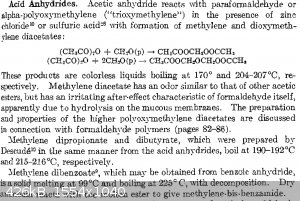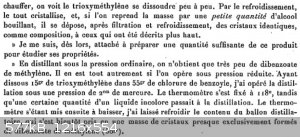clearly_not_atara
International Hazard
    
Posts: 2701
Registered: 3-11-2013
Member Is Offline
Mood: Big
|
|
chloromethylene dibenzoate: stable formyl chloride equivalent
Wenzel in 1914 (attached) reported the reaction of chlorine with methylene dibenzoate, giving the title compound. This acts as a stabilized formyl
chloride in Friedel-Crafts acylations, giving a formylation of anisole in 80% yield with AlCl3 catalyst. Das Papier ist auf Deutsch, so some
translation might be helpful  but it appears that the chlorination is carried
out under ambient conditions in benzene, which should probably be replaced by something safer. but it appears that the chlorination is carried
out under ambient conditions in benzene, which should probably be replaced by something safer.
Methylene dibenzoate in turn is prepared in the literature by the reaction of formaldehyde with benzoyl chloride in the presence of a little catalytic
zinc chloride. Chlorinating reagents and formaldehyde don't exactly sit right with me, but no deaths were reported.
However, there are a couple of other possibilities. Quaternary ammonium benzoates are reported to react with methylene chloride directly:
https://www.ingentaconnect.com/content/ben/coc/2013/00000017...
The more attractive possibilty IMHO is the direct reaction of formaldehyde with benzoic anhydride, which has been reported via citation:
https://aura.american.edu/articles/thesis/Synthesis_of_methy...
However, checking the reference from Descudé 1902 (reference (6)) shows that the Frenchman used benzoyl chloride (and wrote in French). The other
reference for the anhydride method, reference (3), is a little-known book apparently titled "Formaldehyde", which is difficult to find.
Nonetheless, other methylene acylals are known to form by reaction of the anhydrides with formaldehyde. In particular, methylene diacetate is prepared
by the reaction of formaldehyde with acetic anhydride in the presence of Brønsted acids, as reported in various places:
https://patents.google.com/patent/RU2039732C1/en
https://prepchem.com/methylene-diacetate/
Knoevenagel also reported a preparation of methylene diacetate from acetic anhydride in 1914 (attached), but again das Papier ist auf Deutsch, so I
can only weakly parse it.
Anyway, paraformaldehyde and benzoic anhydride with a Brønsted acid at what looks like 60 C to my eyes should eliminate any risk of this awful
bis(chloromethyl) ether stuff, and benzoic anhydride can supposedly be prepared by direct thermal methods from the acid.
I don't know if you can cheat at the chlorination by using e.g. TCCA or something. But since the modern world has mostly moved on to Rieche
formylation, this simpler phosphorus-free version has been forgotten (until now).
Attachment: wenzel1914.pdf (323kB)
This file has been downloaded 54 times
Attachment: knoevenagel1914.pdf (1.6MB)
This file has been downloaded 47 times
[Edited on 04-20-1969 by clearly_not_atara]
|
|
|
EF2000
Hazard to Others
  
Posts: 114
Registered: 10-5-2023
Location: The Steppes, now trapped in the forest zone
Member Is Online
Mood: wrooom
|
|
Okay, also die Übersetzung des experimentellen Teils von Wenzels Arbeit für Ausländer:
| Quote: |
Preparation of the chloromethylene dibenzoate
Methylene dibenzoate is easily obtained from trioxymethylene and benzoic anhydride by the Wegscheider and Späth method in the presence of a few drops
of concentrated sulfuric acid and could be converted into a monochlorinated product in the following manner.
60 g of methylene dibenzoate were dissolved in benzene and treated with chlorine, which had been passed through a wash bottle with sulfuric acid and a
tower with calcium chloride for drying, until a weight gain of 9 g was achieved. After distilling off the benzene, the chlorinated product
crystallised on cooling and was recrystallised from acetone or petroleum ether for purification. In its crystalline form and in its solubility
behaviour, it shows the greatest similarity to unchlorinated methylene dibenzoate. There is also only a difference of two degrees in the melting
point, as it melts at 96, while methylene dibenzoate has a melting point of 98. However, a mixed melting point of the two substances resulted in a
depression of a few degrees. The analysis led to the following results:
I. 0.1966 g of substance yielded 0.1058 g of silver chloride.
II. 0.1973 g of substance yielded 0.1102 g of silver chloride.
III. 0.3058 g of substance yielded 0.6969 g of carbonic acid and 0.1131 g of water.
[Table of composition: parts by elements in 100 parts of substance]
In order to prove that the chlorine atom had actually entered the methylene group, the chlorine product was saponified [hydrolized?] with alcoholic
[caustic] potash. If the hydrogen atom of the methylene had been replaced by chlorine, the chlorine product had to be split into benzoic acid and
formic acid, whereas if substitution had occurred in the ring, it had to yield chlorobenzoic acid and formaldehyde on decomposition.
For the qualitative detection of the decomposition products, 5 g of chloromethylene dibenzoate was dissolved in 4 g of [caustic] potash in alcohol and
boiled for 4 hours under reflux. The excess [caustic] potash was then precipitated as carbonate by introducing carbonic acid, filtered off and the
filtrate evaporated to dryness. The residue was taken up with a small amount of water and filled with hydrochloric acid. The precipitated substance
had a melting point of 121 and was therefore benzoic acid. The filtrate of this reduced mercuric chloride by causing a white precipitate that turned
black with ammonia, thus it was calomel.
The chlorination therefore proceeded according to the equation:CH2(OCOC6H5)2 + Cl2 =
CHCl(OCOC6H5)2 + HCl
In addition, the formation of formic acid could also be monitored quantitatively using the method of Vortmann and Skala.
5.1734 g chloromethylene dibenzoate was boiled with 5 g of [caustic] potash in 60 cm3 alcohol for 4 hours, then, as described earlier, the
main quantity of benzoic acid was removed, the filtrate etherified [ether added?], the free acid removed from the ethereal solution by shaking with
sodium hydroxide solution and the sodium formate solution obtained evaporated. The residue was taken up with water, neutralised with a few drops of
pure [glacial?] acetic acid and mixed with mercuric chloride. The precipitated mercuric chloride was dried on a tared filter at 100 degrees, weighed
and its weight was 0.8223 g, whereas 0.8177 g was theoretically required. |
Translator's note: Kali is translated as "potash", but it should be actually "caustic potash", since "Alkoholisches Kali" is KOH in ethanol.
Wroom wroom
|
|
|
bnull
Hazard to Others
  
Posts: 167
Registered: 15-1-2024
Location: Between the Atlantic and the Pacific Ocean
Member Is Offline
Mood: Sleepy (again)
|
|
Quote: Originally posted by clearly_not_atara  | | The other reference for the anhydride method, reference (3), is a little-known book apparently titled "Formaldehyde", which is difficult to find.
|
We have one copy of the first edition (1944) in the Library, halfway to the end of the page.
Quod scripsi, scripsi.
B. N. Ull
P.S.: Did you know that we have a Library?
|
|
|
clearly_not_atara
International Hazard
    
Posts: 2701
Registered: 3-11-2013
Member Is Offline
Mood: Big
|
|
^Thanks. The book is similarly circumspect. It also cites Descudé, but a different paper (Compt. Rend. 133, 372 (1901))
than the Descudé paper (1902) that was cited in the thesis. I don't have the time to go digging through the Compt. Rend. archives right now,
they're all open access, but also in French and not very searchable. Overall it seems to support my contention that almost any acid anhydride reacts
with formaldehyde to give the methylene acylal.
As to why the dibenzoate acylal is preferred here, I have two theories: first, the benzoate side-chain is not attacked as easily by chlorine, and
second, the title of the paper by Wenzel is discussing sterics.

EDIT: Found it. Bz2O reacted with trioxane only with ZnCl2; no attempt with H2SO4. The rxn mixture from Bz2O and trioxane was recrystallized from
boiling ethanol, although it seems that the yield was not satisfactory, since he reports using benzoyl chloride "to prepare a sufficient quantity of
this product to study its properties". Or perhaps benzoyl chloride was just cheaper in France in 1901?
Ambient-pressure distillation was not successful (product decomposes before boiling) so reduced-pressure distillation was used to purify the product.
Distillation reported at 2 centimeters of mercury (20 mmHg) at 118 C. In order to isolate a sufficient amount of product the experimenter switched to
BzCl.
Descudé reports that methylene dibenzoate crystallizes "remarkably easily", is moderately soluble in ether, acetone and benzene (8%, 18% and 27% w/w
resp.), poorly in ethanol (2.5%) at rt.
[Edited on 16-3-2024 by clearly_not_atara]
 
[Edited on 04-20-1969 by clearly_not_atara]
|
|
|
clearly_not_atara
International Hazard
    
Posts: 2701
Registered: 3-11-2013
Member Is Offline
Mood: Big
|
|
Can't edit the last post anymore but the thesis above:
https://aura.american.edu/articles/thesis/Synthesis_of_methy...
does mention the use of H2SO4 as the catalyst and BzCl as the reagent (200 C, 3h, 1:1 paraformaldehyde:BzCl, refluxing neat) although the yield was
lower (50%) and the use of a longer rxn time did not improve matters due to decomposition. So the Brønsted acids appear to be effective catalysts,
although nobody has given an example of the ideal chloride-free reaction. Using TsOH instead of H2SO4 may give less decomposition.
Descudé meanwhile is giving no conditions; he simply says that he heated the mixture of Bz2O and (CH2O)3 with cat. ZnCl2 until the latter had fully
dissolved and then the mixture formed homogenous crystals on cooling, which were recrystallized by taking up in boiling ethanol, filtering, and
cooling. This shows that a rxn must have taken place, because the precursors will either dissolve in or react with ethanol, and therefore won't
crystallize out. But yields, quantities, temperatures, etc, are missing.
And thanks very much to EF2000 for the translation!
[Edited on 04-20-1969 by clearly_not_atara]
|
|
|
|